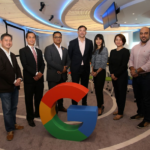
(Source – Shutterstock)
Businesses in Southeast Asia can expect a lot more from Google in 2023
|
Getting your Trinity Audio player ready... |
For Google, 2023 is expected to see businesses in Southeast Asia expand their capabilities in how they use and manage their data on the cloud. This not just includes looking into increasing AI adoption but also how they can better secure their data in the cloud.
Ruma Balasubramaniam Managing Director, Southeast Asia, Google Cloud explains more in the second part of her conversation with Tech Wire Asia.
As some businesses may take a cautious approach towards their tech expansion in 2023, which areas in the cloud will be the most important area of focus?
We’ve discussed (in the first article) the importance of implementing an open data cloud approach, which we believe will continue to be businesses’ most important area of focus and act as a precursor to wider AI adoption. Other important and complementing areas of focus in 2023 involve turning to the cloud to:
● Strengthen security
● Power collaboration equity in the hybrid workplace
The business benefits of the shift from legacy or on-premise infrastructure to the public cloud are clear: increased productivity, enhanced customer experiences, decreased capital expenditure, and reduced time-to-market for new products and services. Security is another key cloud adoption consideration.
Effective security requires a combination of tools, best practices, and the implementation of these tools and best practices. On average, enterprises deploy 45 cybersecurity-related tools on their networks. The reality, however, is you might decide to procure all the security hardware and software in the world, but if your password is “password1234,” you would still be vulnerable. What we’ve therefore seen is, organizations end up buying the tools, but don’t implement the right governance and policies around them – most hacks or breaches happen because of human error.
With this situation in mind, companies – including large and traditional conglomerates in regulated industries – are starting to realize that public clouds operate at a sufficient scale to implement higher levels of security that few organizations can fully construct on their own. Google has been operating securely in the cloud for more than 20 years. Google Cloud is therefore offering enterprises the same modern, built-in protections that Google uses to secure its applications and data at a global scale.

Ruma Balasubramanian, Managing Director, Southeast Asia, Google Cloud (Source – Google)
We are committed to delivering on the promise of a Trusted Cloud, which is built on three pillars:
- A secure platform that delivers transparency and enables sovereignty: We provide a secure foundation that enterprise customers can verify and independently control. It enables them to move from their own data centers to the cloud while maintaining control over data location and operations and helps ensure compliance with local regulations.
- A proven zero-trust architecture: Data is encrypted by default, whether it is at rest, in motion, or in transit – and it can be accessed only if there is a security key. Additionally, we offer battle-tested technology that protects data against the threats that Google sees and defends against every day. As a result, Google Cloud customers can operate with confidence that threats from ransomware, account takeovers, bots, phishing, and even more advanced attacks are minimized, detectable, and recoverable.
- Shared fate, not shared responsibility: As a flywheel of increasing trust drives more businesses to transition to the cloud, we are compelled to have more skin in the game. This is why Google Cloud operates with a mutually dependent shared fate model: “if our customers are not secure, then we’re collectively not successful.” It is our responsibility to be active partners in ensuring our customers deploy securely on our platform, and not delineators of where our responsibility From day one, we help customers implement best practices for safely migrating to and operating in our cloud. These include:
- A Command Center for visibility of vulnerabilities for cyber risk management
- Using ML to alert operational security engineers to potential incidents
- Having our investigation and incident response teams triage, investigate, and respond to these potential incidents 24 hours a day, 365 days a year
- Conducting exercises to measure and improve the effectiveness of our detection and response mechanisms
The use of public cloud services is increasing, expanding to sensitive workloads and new data types. Giving customers control over their data in the cloud is no longer a nice to have, it’s essential for helping more businesses adopt cloud technologies. At Google Cloud, we ensure that customers can control their data, have choices for their data, and can count on our services to protect their data across geographies, evolving regulatory standards, and what’s to come.
In the past, digital natives like Ninja Van and GoTo Group have been quicker in adopting and leveraging the cloud. What’s changed, however, is the growing recognition amongst large and traditional conglomerates in regulated industries that the cloud can have inherent security advantages over on-premise infrastructure. The promise of a Trusted Cloud is one of the reasons why the likes of AFFIN Bank and Majlis Agama Islam Wilayah Persekutuan (MAIWP) in Malaysia have recently chosen Google Cloud to advance their digital transformation objectives.
In 2023, businesses will continue trying to figure out how to combine on-site and off-site work into an efficient hybrid model. We see one theme emerging: the need for “collaboration equity” and how it can be powered by cloud-based innovation.
Multiple surveys and studies have revealed that employees now prefer to work in a hybrid or fully remote capacity. The challenge here is that we have a broad spectrum of possibilities and options. Businesses have implemented flexible work arrangements in different ways: some institute a set number of days employees ought to spend in the office each week, while others give their staff the freedom to literally work anytime, anywhere. We also cannot discount the fact that different individuals within the same company – or department – have their own unique situations and preferences.
Collaboration equity is when all workers have the ability to contribute and communicate equally, regardless of location, role, experience level, language, or device preference. A lack of collaboration equity can stem from hierarchies in video calls or language barriers on international calls. It can mean junior employees feeling disempowered to speak up in meetings, off-site employees struggling to reach their on-site managers, or frontline workers lacking the communication tools their office colleagues enjoy. When these disparities add up, they can damage an individual’s well-being, career potential, and effectiveness. When they permeate an organization, team performance suffers, innovation wanes, and talent leaves.
Designing company culture, corporate policies, and physical spaces that are more inclusive and maximize participation will improve collaboration equity. Cloud technologies will also undoubtedly play a crucial role. When we were all participating in meetings remotely during the pandemic, everyone shared equal-sized tiles on videos. In a hybrid environment, this becomes distorted. The people participating remotely appear giant on a conference room monitor, while the people in the conference room appear tiny on screens at home. It can be difficult to decipher who’s even in the room. This is certainly not equal representation.

2023 will see enterprises lean into cloud-powered innovations to solve for collaboration equity, rather than risk a murky middle ground where no one is truly satisfied with the company’s hybrid work model. (Source – Google)
2023 will see enterprises lean into cloud-powered innovations to solve for collaboration equity, rather than risk a murky middle ground where no one is truly satisfied with the company’s hybrid work model. Two simple examples of such innovations are adaptive framing with AI-powered cameras that adjust for low-light environments and auto-zoom to keep all participants in focus, and the names of individuals who are joining a video call from a meeting room being displayed on-screen.
To enable collaboration equity for frontline workers – who are the backbone of industries like manufacturing, healthcare, retail, and transport – we see enterprises turning to an integrated cloud-native platform that offers these employees everything they need to complete their tasks most effectively: access to files, seamless collaboration, corporate communication channels, intuitive search functions, and the ability to work on mobile devices securely without a VPN.
We’ve already seen a logistics company create its own customized features that integrate with Google Workspace to allow staff delivering parcels to easily mark a delivery as complete by uploading a photo to its corporate system. We’ve also seen an airline having its cabin crew and ground staff use Google Drive to easily share details about in-flight meals and galley management with each other.
We’re not advocating a “choose your own adventure” mentality nor a one-size-fits-all model. At the end of the day, it’s about finding ways to empower teams and meet the preferences of individual members in a deliberate fashion that supports the broader organization.
Google Cloud made major announcements in 2022 in Southeast Asia, especially with the establishment of cloud regions in some countries. Can businesses look forward to more in 2023?
Nearly every organization that we are speaking with is taking a more inspired view of the role of IT. They see IT evolving from that of “custodian” to “enabler,” with business imperatives like agility, customer experience, productivity enhancements, and environmental sustainability eclipsing conventional infrastructure and cost considerations. The simple lift-and-shift exercise where systems are moved from data centers to the cloud – to “run faster, cheaper, and more reliably” – is acknowledged as the starting point. Organizations want to transcend this old mantra. They are asking Google Cloud what we can unlock for their business teams and how we can open doors to new opportunities.
We currently operate cloud regions in Indonesia and Singapore, and in 2022, we announced plans to double the number of cloud regions we operate in Southeast Asia by adding new cloud regions in Malaysia and Thailand. The electricity consumption of all of our cloud regions are already matched 100% with renewable energy on an annual basis. When they launch, the Malaysia and Thailand cloud regions will be consistent with this.
It is therefore important to understand that not all data centers and cloud providers are equal, and one area that businesses can look forward to in 2023 that’s unique to Google Cloud is cloud-based services that can help them decarbonize both their IT and business operations.
2022 was the year where enterprises acted on the belief that it is now or never for climate action. In the past 12 months, every conversation that I have had with customers’ Board of Directors, CEOs, and CTOs have involved sustainability as a strategic imperative. They acknowledge that our planet urgently needs it, and their customers, employees, and investors increasingly demand it.

Google plans to double the number of cloud regions it operates in Southeast Asia by adding new cloud regions in Malaysia and Thailand.(Source – Shutterstock)
Whether it is financial services institutions like Prudential, retailers like Yim Platform, telcos like Telkom Indonesia, or digital natives like Sky Mavis; we saw organizations shifting from traditional, self-managed data centers – or even switching from their previous cloud providers – to an operationally carbon neutral option like Google Cloud to immediately transform their IT carbon footprint and improve their sustainability profiles.
As a result of Google becoming the first major company to match its energy consumption with 100% renewable energy (not just carbon credits, but power purchase agreements of sources like wind and solar) since 2017, Google Cloud is best positioned to support our customers by operating the cleanest cloud in the industry, helping them act today to decarbonize digital applications and infrastructure and achieve their most ambitious sustainability targets. We’re taking this further by announcing Google’s founding membership in the newly launched Asia Clean Energy Coalition (ACEC), a multi-stakeholder initiative to expand corporate access to clean energy across Asia.
The enterprises that stood out in 2022, however, are the ones who have not just transferred their IT operations from carbon-emitting to renewable energy sources, but those who have also used cloud-based tools to drive operational improvements (i.e., use less energy across their IT, business, or supply chain operations in the first place) or design products to address key climate challenges (e.g., deforestation, sustainable financing, fishing in restricted areas).
Yim Platform, Central Retail’s food business subsidiary in Thailand, for instance, is committed to building more sustainably by exploring the use of Google Cloud’s Carbon Sense suite to accurately measure, report, and reduce its cloud carbon emissions. This is set to contribute to its parent company’s goal of a 30% reduction in its carbon emissions by 2030. Another example is JB Cocoa, a major cocoa ingredient producer in Malaysia. Having migrated its supply chain systems onto Google Cloud infrastructure that’s powered by 100% renewable energy, JB Cocoa is now also using Google Cloud’s data management capabilities to ensure that it is sourcing cocoa beans from traceable and sustainable farms, while identifying and addressing issues of deforestation in its supply chain.
There are many more examples of organizations using cloud-based tools and services to address key climate challenges, from companies joining the Point Carbon Zero Program in Singapore to a digital fishing ecosystem builder in Indonesia. In 2023, we expected even more organizations to actively develop cloud-based solutions – with an open data cloud approach as the foundation – that can help them assess climate-related risks and increase climate resilience.
READ MORE
- Safer Automation: How Sophic and Firmus Succeeded in Malaysia with MDEC’s Support
- Privilege granted, not gained: Intelligent authorization for enhanced infrastructure productivity
- Low-Code produces the Proof-of-Possibilities
- New Wearables Enable Staff to Work Faster and Safer
- Experts weigh in on Oracle’s departure from adland




